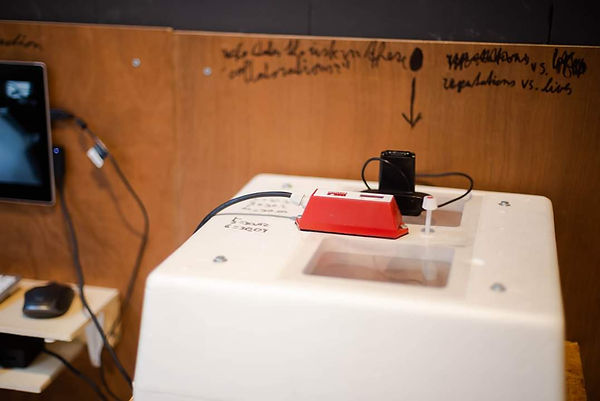
Ever it Takes
Embryonic care through semi-permeability
EVER IT TAKES Ever it Takes (2020) is a performance and installation by Jacco Borggreve developed during a Summer Sessions residency in V2_ Lab for Unstable Media in 2020.
In the long durational performance, Borggreve spent two months nurturing developing lizard embryo's. Using Peltier modules, the artist generated electricity using his body heat to provide the necessary electricity to provide power to the incubator housing the reptile eggs. He also sourced and processed nutrients and moisture from his body which further aided the development of the embryo.
Ever it Takes is an attempt to establish a relationship of responsibility and care, following the ideas of Donna Haraway about ‘making kin’ (Donna Haraway: Staying with the Trouble). By acknowledging interdependence Ever it Takes functions as a ‘natural, cultural’ community of bearded dragons, mechanisms and parents. This community is a form of material speculation that invents practices of care, imagining improbable collaborations as a proposal for ‘possible futures and implausible but real nows’.
‘Making kin’ can be read as an ethics of care, which refers to placing values of relationship and care over reason and logic. Caring was engendered as feminine and devalued. In contrast, Ever it Takes performs and values interspecies caring in public and private. The installation consists of a lab setting that establishes the connection between the artist body and an incubator holding lizard eggs. The mechanisms in the lab allow the artist’s biological matter to contribute as nutrients, as molecules that have passed through his body for the development of the lizard embryo.
Dragon eggs may seem independent, but their shell is semi-permeable. Water and oxygen can pass through and is needed for the maturation of the embryo. This intimacy can be regarded as a birthing ritual resulting in a unique kind of interspecies parenthood.


Fig 1. Installation consisting of a bed, Peltier modules, ECG, screen, battery and incubator containing eggs.

Fig 2. Incubator housing the eggs.

Fig 3. Eggs in incubator


Fig 4. Embryonic development after three weeks
Fig 5. Embryonic development after five weeks.

The state of the embryo within the eggs can easily be monitored using lights and a high contrast camera. Different eggs were photographer each session to ensure minimal interference in the development.
After three weeks, a heartbeat could be seen. After six weeks, the embryos seemed to rotate away from the light indicating perception and awareness of the light.
Fig. 6. Embryonic development the moment before hatching.

Fig 7. Body of artist and Peltier modules.

Fig. 8. Borggreve performing at night.



Fig. 9,10,11. As the egg approaches hatching, the egg starts to look somewhat deflated. The newborn slices open the egg sticks out it's head before resting up to 48 hours absorbing the egg yolk through it's umbilical cord.